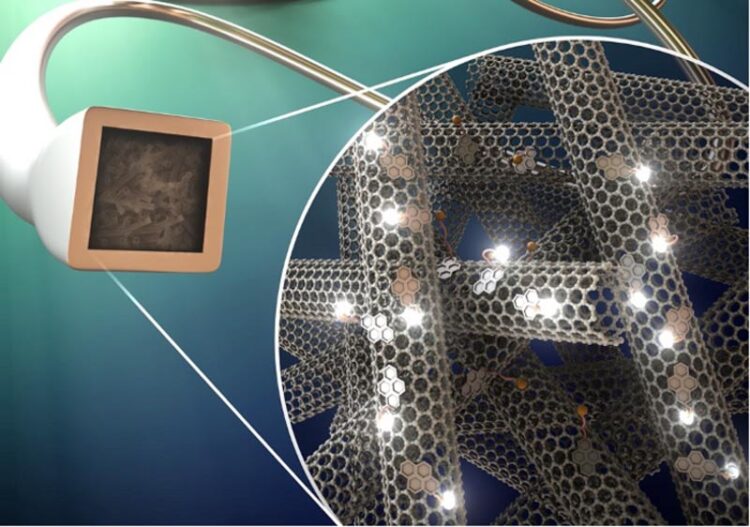Reading chemicals inside the brain

The aptamer-coupled microelectrode fiber sensors (apta-μFS) for neurochemical sensing.
Credit: T.Saizaki et al.
… with an aptamer/microelectronic fiber combination.
A research group has developed a neural device that detects specific neurotransmitters in the brain with high sensitivity and selectivity by combining multifunctional fibers and DNA molecular probes.
Details of their research were published in the journal Analytical Chemistry on April 24, 2023.
It is estimated that over a billion people suffer from brain disorders worldwide. Current therapeutic techniques use electrical modalities to establish an interface with the brain. This typically involves electrodes being used to read electrical potential or deliver electrical currents to specific tissues of organs in the body.
However, cells inside the brain communicate with each other via chemical signals, and thus researchers have been looking for ways to measure and manipulate both the electrical and chemical signals.
One such breakthrough in this regard has been microscopic, thermally-drawn microelectronic fiber-based neural probes that can act as an interface with the brain across electrical, chemical, optical, and mechanical modalities. Still, the capabilities of this technology for studying intrinsic in-brain chemistry have yet to be explored, and few attempts have studied how it could be integrated with multi-modal and multi-level brain studies.
“We expanded the capabilities of the fibers to include neurochemical sensing,” says Dr. Yuanyuan Guo, associate professor at Tohoku University’s Frontier Research Institute for Interdisciplinary Sciences (FRIS), and leader of the research group. “We coupled aptamers, a new type of biosensor comprising a single strand of synthetic DNA with customizable sequences, on the microelectronic fibers. These defined aptamers sense neurochemicals with high sensitivity and high selectivity.”
Aptamers can be thought of as keys that specifically unlock the locks of certain target molecules. Like a key fits into a specific lock and opens it, an aptamer can bind to a specific molecule and interact with it in a selective manner.
In the study, the defined aptamer sequences bound to specific molecules with a high affinity, inducing a reversible three-dimensional conformational change from a relatively simple chain structure into a complex structure wrapping around targets. Aptamers were tagged with ferrocene as an electrochemical readout for target molecule and aptamer binding.
The research group focused on dopamine due to its physiological significance in mediating learning behavior and motivation. But Guo points out that this sensing mechanism is applicable to other molecules regardless of their charge or electrochemical profile. “Our discovery provides a universal method for fiber surface modification, to monitor wide-range molecules of interest.”
Ultimately, the breakthrough will hopefully enable the development of new brain research and methods for the prevention and treatment of diseases of the brain and organs that have not been elucidated to date.
Journal: Analytical Chemistry
DOI: 10.1021/acs.analchem.2c05046
Article Title: The development of aptamer-coupled microelectrode fiber sensors (apta-μFS) for highly selective neurochemical sensing
Article Publication Date: 24-Apr-2023
Media Contact
Public Relations
Tohoku University
public_relations@grp.tohoku.ac.jp
All latest news from the category: Life Sciences and Chemistry
Articles and reports from the Life Sciences and chemistry area deal with applied and basic research into modern biology, chemistry and human medicine.
Valuable information can be found on a range of life sciences fields including bacteriology, biochemistry, bionics, bioinformatics, biophysics, biotechnology, genetics, geobotany, human biology, marine biology, microbiology, molecular biology, cellular biology, zoology, bioinorganic chemistry, microchemistry and environmental chemistry.
Newest articles

Sea slugs inspire highly stretchable biomedical sensor
USC Viterbi School of Engineering researcher Hangbo Zhao presents findings on highly stretchable and customizable microneedles for application in fields including neuroscience, tissue engineering, and wearable bioelectronics. The revolution in…

Twisting and binding matter waves with photons in a cavity
Precisely measuring the energy states of individual atoms has been a historical challenge for physicists due to atomic recoil. When an atom interacts with a photon, the atom “recoils” in…

Nanotubes, nanoparticles, and antibodies detect tiny amounts of fentanyl
New sensor is six orders of magnitude more sensitive than the next best thing. A research team at Pitt led by Alexander Star, a chemistry professor in the Kenneth P. Dietrich…





















